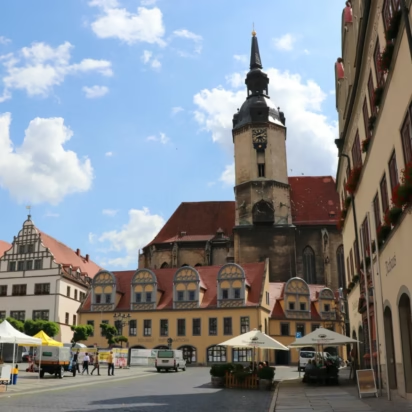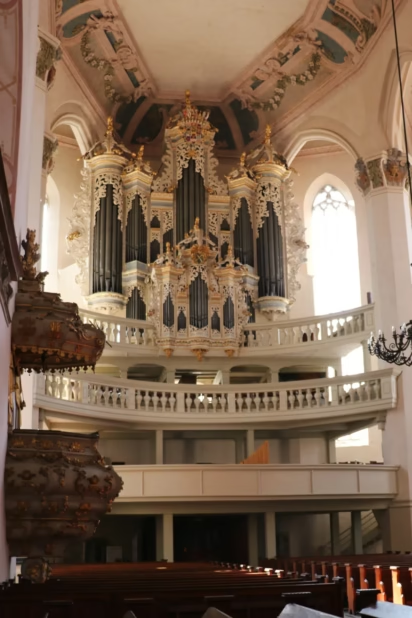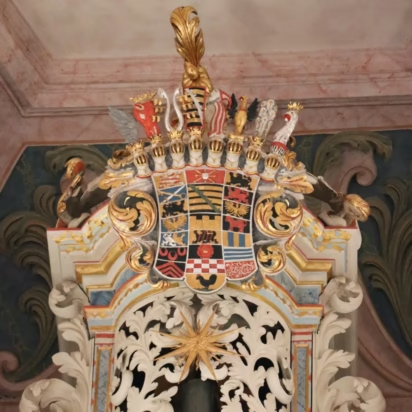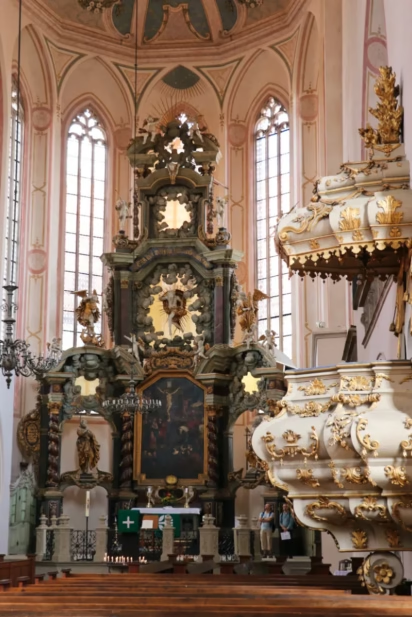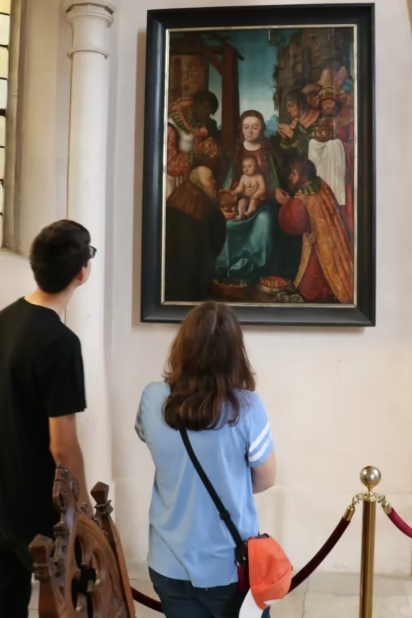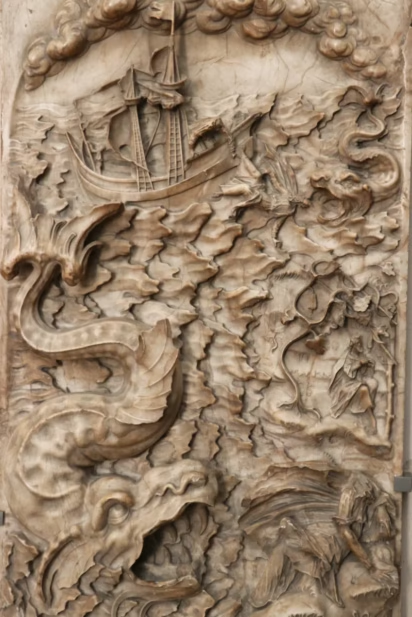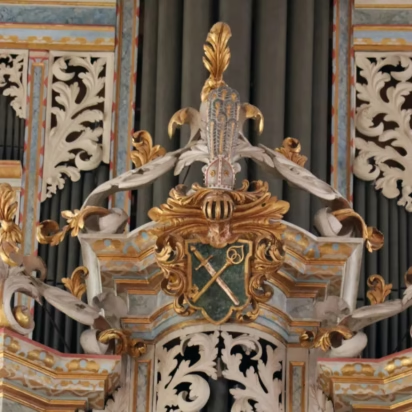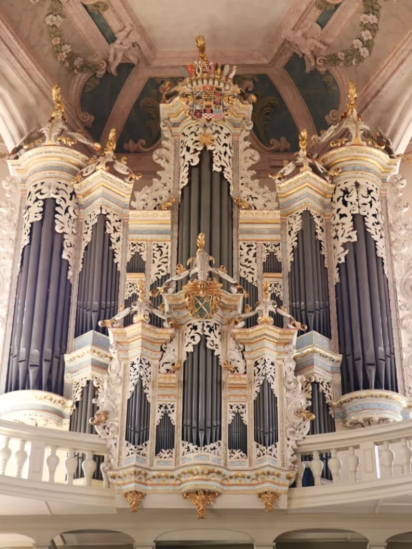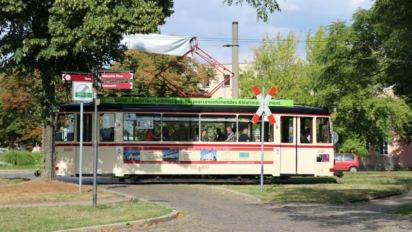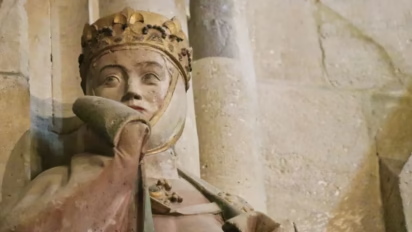The largest organ JS Bach played that is still in working condition is the Hildebrandt Orgel in the Stadtkirche St. Wenzel in Naumburg, Germany.

In Naumburg, the late Gothic Stadtkirche St. Wenzel is totally overshadowed architecturally by the UNESCO World Cultural Heritage-listed Romanesque-Gothic Cathedral of St Peter and St Paul. However, in St Wenzel’s fairly unassuming Baroque interior is the largest instrument made by the master organ builder Zacharias Hildebrandt. Johann Sebastian Bach and Gottfried Silbermann made the final appraisal before approving the organ. It is fully restored making it the largest organ in existence personally played by Bach. It is not a hidden secret — the organ is world-famous even if Naumburg is still somewhat off the beaten track for foreign visitors. Seeing this Baroque organ is wonderful, hearing it is sublime.
Stadtkirche St Wenzel in Naumburg
The Stadtkirche St Wenzel near the market square of Naumburg in Saxony-Anhalt, Germany, was the main church of the civilian town while the more famous UNESCO World Cultural Heritage-listed Naumburg Cathedral was the church of the bishop.
Although the history St Wenzel’s Church goes back to at least 1228, several town fires means that the current church is mostly a late Gothic structure built after 1426 and expanded with a west portal in 1510/1520. The interior is mostly baroque.
Bishop and burghers often failed to get along in the same city. Naumburg was no exception, so the tower of St Wenzel was purposely built higher than those of the cathedral. At 72 m, it is still the highest point in modern Naumburg — it is 242 steps to the viewing platform.

The architecture of St Wenzel’s is interesting. The church has a long, narrow choir on the eastern end attached somewhat awkwardly to a short, but wide double-bay triple-nave. The choir is a polygon formed from the five sides of a decagon (10) while the polygon at the western nave took its five sides from a hexadecagon (16). This odd floorplan necessitates an interesting roof layout too — best appreciated from above: in addition to the regular roofs over the choir and the crossing, a further ring-shaped roof runs from the tower to the south portal.
Baroque Interior of St Wenzel in Naumburg

The interior of St Wenzel is mostly light-colored Baroque beautifully lit through the slender but tall Gothic windows. Much of the interior was redone between 1680 and 1724, including the altar, the magnificent organ case, the new flat ceiling, and the stucco work.
Large Baroque Hildebrandt Bach Organ in Naumburg
The most impressive item in St Wenzel’s is without a doubt the magnificent Baroque organ. This is the largest organ played by Bach and the largest organ built by the famous organ builder Zacharias Hildebrandt (1688-1757) that is still in working condition. It is played often.
Johann Sebastian Bach was instrumental in the design of this organ. He cooperated closely with his friend Hildebrandt, who in 1743 received the contract for replacing the existing organ with a new, larger instrument. On 27 September 1746, J.S. Bach and master organ builder Gottfried Silbermann — Hildebrandt’s former teacher — tested and approved the organ.
In 1748, Johann Christian Altnikol became the first organist — a year later he became Bach’s son-in-law. No existing organ in the world has more Bach in it. Altnikol observed in 1753 “… und wer diese Orgel gesehen und gehöret, der is niemals ohne Bewunderung davon hinweggegangen.” (Implying, although the German is more descriptive and stronger, “no one who saw or heard this organ had ever left without being impressed”)
Through the centuries, the organ was altered to reflect changes in taste and restored several times. The latest restoration completed in 2000 by Hermann Eule Orgelbau Bautzen returned the organ largely to its original condition to reproduce the sound as closely as possible to what was heard in Bach’s lifetime.
The Hildebrandt organ has around 3,300 pipes, 52 stops and is played via three manuals and a set of pedals — see full technical description at Hildebrandt-Orgel.
The beautiful Baroque organ case is actually older than the Hildebrandt organ itself. It was made in 1698 by Johann Göricke and remained in place from the previous organ.
The huge flamboyant coat of arms at the top of the organ case is that of the short-lived Duchy of Saxe-Zeitz. It was established in 1656 as a secundogeniture of the electorate of Saxony but returned to the main Saxon Wettin line in 1718. The coat of arms is explained (in German) but Naumburg is easy to recognize by the symbols of the patron saints: key (St Peter) and sword (St Paul). Naumburg’s shield is again used lower on the organ box — the current town shied is the symbols in red on a white background.
Art in St Wenzel in Naumburg

The tall high altar in the choir is from around 1680. It was carved by Heinrich Schau and painted by Oswald Harms. At its center is a painting of the crucifixion with some of the sponsoring town councilors and wives in the foreground. It is flanked by statues of Peter with key and Paul with a sword — the two patron saints of Naumburg. (The Naumburger Dom St Peter und St Paulus is named after them and their symbols appear numerous times in Naumburg — not only on the town shield.) Christ has risen is at the center flanked by the Archangel Michel killing a dragon and an angel with a harp. Higher up are more angels and the holy spirit in the form of a dove.
The church has two early 16th-century paintings by Lucas Cranach (or possibly his workshop): “Christ Blessing the Children” and the “Adoration of the Magi”. A further “Adoration of the Magi” is possibly by Hans von Kulmbach, 1510, while the “Adoration of the Shepherds” is by Bartholomäus Spranger (around 1600).
The church has several monumental graves and memorials. Note the alabaster relief with Jonah and the Whale (1640).
The monumental pulpit was made in 1725-29 and further enhanced in 1766. The bronze baptismal font — big enough for full immersion of the child — is from the mid-15th century.
Visitors Information St Wenzel’s in Naumburg
Opening Hours
St Wenzel’s Church is open Monday to Saturday from 13:00 to 15:00 in April and November and from 10:00 to 17:00 from May to October. Sundays only for services and the noon concerts. Admission is generally free but charged for the half-hour concerts — see below.
The Wenzelsturm tower is generally accessible April to October — a few days extra possible for holiday weekends — Tuesday to Sunday from 10:00 to 17:00. It is 202 steps to the tower apartment (Türmerwohnung) at 45 m and a further 40 steps to the viewing platform at 54 m. Tickets are €2 (€1 for children).
Concerts on the Hildebrandt “Bach” Organ in Naumburg
The Hildebrandt Orgel in the Stadtkirche St Wenzel is frequently played — both in the regular noon concerts, the summer Friday evening international concert series, and ad hoc concerts.
From May to October the organ is usually played for 30 minutes from noon (“Orgel Punkt 12”) on Wednesday, Saturday, Sunday, and holidays — there are sometimes gaps in the schedule. Admission is €4. Add €2 for a close-up view of the organ afterward.
The program is available at Hildebrandt-Orgel that also includes a few of the other interesting organs in the region. Tickets are very reasonable — often less than €10 per person with discounts for students and families.
Experienced organists and students may arrange to play on the organ — the cost is around €140 per hour plus a fee for the obligatory introduction to the finer aspects of this historic instrument.
Naumburg has several small hotels with good Tripadvisor ratings within easy walking distance of the church — a good option for the Friday night concerts and often better value than staying in a nearby city any time of the year.
Transportation to Stadtkirch St. Wenzel in Naumburg
Stadtkirch St. Wenzel is on Topfmarkt at the large market square in the center of old town Naumburg. From the Naumburg (Saale) station, it is around a 25-minute walk (2 km) with the final 10 minutes from Naumburg Cathedral along the pleasant main shopping street.
Naumburg’s bus service is surprisingly complicated and not ideal for sightseeing purposes. A taxi from the station may be more sensible. The historic tram cars are also an interesting option — they run mostly in summer from the station around the outskirts of the old town with all stops just a few blocks from the center.
Naumburg an der Saale has very good railway links to other cities in Germany in the immediate region including Halle, Leipzig, and Jena — see German Railways timetables for travel planning to Naumburg (Saale) Hbf. Trains to Halle and Leipzig take around half an hour while Berlin may be reached in two hours — change trains in either Halle or Leipzig.
If using only local trains in the region, the Saxony-Anhalt Ticket is a great savings option. This Länderticket covers local train and bus transportation in all of Saxony-Anhalt, Saxony, and Thuringia, and has the same validity and price as the Sachsen or Thuringia Tickets.
Naumburg is a pleasant town of just over 30,000 inhabitants. It has several small hotels that get good Tripadvisor ratings and may be much better value than sleeping in one of the nearby cities.
The top sight in Naumburg is the Romanesque Gothic cathedral. It is a UNESCO World Cultural Heritage-listed site famous for its architecture and Gothic art by the Master of Naumburg including the sculptures of Ute von Ballenstedt and the cathedral donors that are amongst the most treasured medieval artworks in Germany. The cathedral has a large modern Eule organ that is also often heard in concerts.
